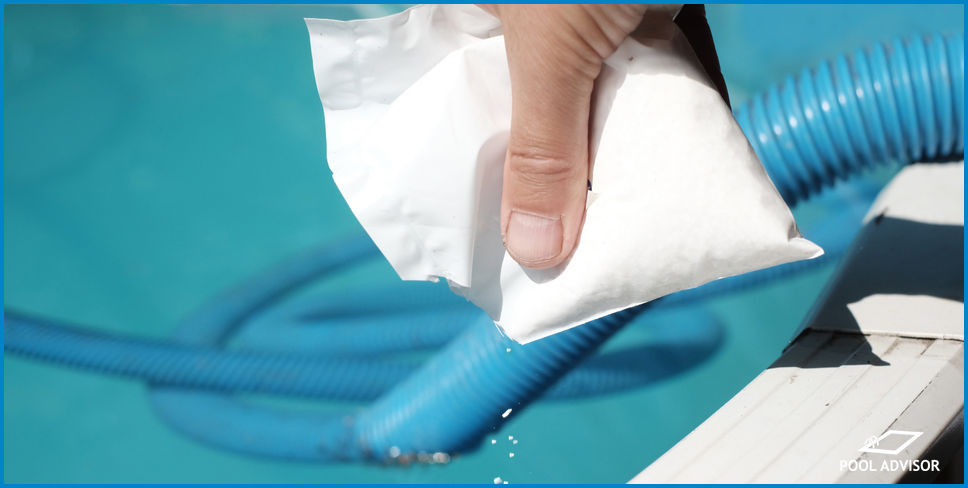
Soda Ash vs Baking Soda - Are They The Same Thing For Pools?
Soda ash and baking soda are both products that are commonly used in swimming pool maintenance. Because these products have similar names, many people wonder: is soda ash the same as baking soda?
In this article, we will talk about the uses for soda ash and baking soda, the differences between these two products, and when you should use one over the other.
Soda Ash vs Baking Soda: Are They The Same Thing?
Soda ash and baking soda are both products that are used to alter the overall acidity of your pool water. While both of these products are used to create increases in the pH of your pool, soda ash and baking soda are not the same thing.
Soda Ash
Soda ash is sold by pool supply stores as pH increaser. Soda ash is composed of the compound sodium carbonate, and when added to your pool, it substantially lifts both the pH and alkalinity.
How To Use Soda Ash
Directly before you intend to use soda ash, measure the pH of your pool using an appropriate test kit. Afterwards, calculate the amount of product that you need to use in your pool.
This alkalinity calculator can come in handy here.
Always consult your product’s packaging for dosing information. You should never add more than 10g of soda ash per 1,000L of pool water at a time.
After measuring out the correct dosage of soda ash, mix this product in a bucket of pool water. After it is dissolved, add the solution to the pool near the pump system intake while the filter is running.
Allow the pool to circulate for 4-5 hours before retesting the pH. If adding a larger dose, longer waiting periods should be observed: up to a 24 hour maximum.
Pros And Cons Of Soda Ash
Soda ash is relatively inexpensive, costing about $6 per kilogram. If you are able to buy this product in bulk, you may be able to get a better price per quantity.
It is a very useful chemical because it can target pH without impacting the total alkalinity very much.
One downside of soda ash is that it is very strong, making it easy to overshoot the pH levels in your pool and go from an acidic environment (low pH) to an alkaline environment (high pH) very quickly.
On the other hand, this means that you don’t need too much, which makes it a very cost-effective option.
Baking Soda
Baking soda, also known as sodium bicarbonate, is sold by pool supply stores as a pH buffer. Sometimes called a total alkalinity increaser, this product raises the amount of alkaline compounds in your water, therefore preventing unexpected drops in pH levels.
Baking soda creates an increase in these total alkalinity levels while also creating a slight increase in pH.
How To Use Baking Soda
Directly before you intend to use baking soda, measure the pH and total alkalinity levels of your pool using an appropriate test kit. Afterwards, use our baking soda calculator to figure out the amount of product that you need to use in your pool.
In a pool of 50,000 litres, it takes approximately 2.5kg of baking soda to create a raise in total alkalinity levels of 30 parts per million.
After measuring out the correct dosage, pre-mix the sodium bicarbonate in a bucket of pool water. Then, add the solution to the pool near the pump system intake while the filter is running. Allow the pool to circulate for 3-4 hours before retesting your total alkalinity and pH levels.
Pros And Cons Of Baking Soda
Baking soda is slightly more expensive than soda ash, costing about $7.50 per kilogram depending on your supplier.
One downside of using baking soda is that it only has mild pH increasing properties. Because baking soda has a pH of approximately 8.3 (it contains the bicarbonate, not carbonate form of alkalinity), pH levels that are exceptionally low may need to be treated with soda ash after alkalinity levels are fixed.
In saying this, it is a useful chemical for lifting the alkalinity without affecting the pH too much.
Soda Ash vs Baking Soda: Which To Use?
When deciding if you should use soda ash or sodium bicarbonate, it is important to look at the total alkalinity content of your pool as well as the pH. Ideal total alkalinity levels range from 80-120ppm, while ideal pH levels range from 7.2-7.6.
If you have low total alkalinity, you should always make adjustments to these levels first using baking soda. If you attempt to treat low pH while total alkalinity is low you will likely overshoot your pH target once you adjust the alkalinity.
Using baking soda will increase pH slightly, so retest your pH after allowing the baking soda to circulate in order to determine if the use of soda ash is still needed.
Conclusion
When deciding between soda ash vs sodium bicarbonate, it all comes down to the total alkalinity levels of your pool. Regardless of your pool’s pH, total alkalinity should be adjusted first in order to create changes in pH that will actually last.
Do you have any questions about soda ash vs. baking soda for pools? Get in touch with us in the comments, we’d love to help!

Louis
A chemical engineer by trade, Louis is committed to debunking myths in the pool industry by explaining the underlying chemistry and making it accessible to all.
